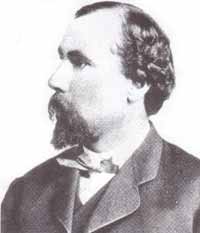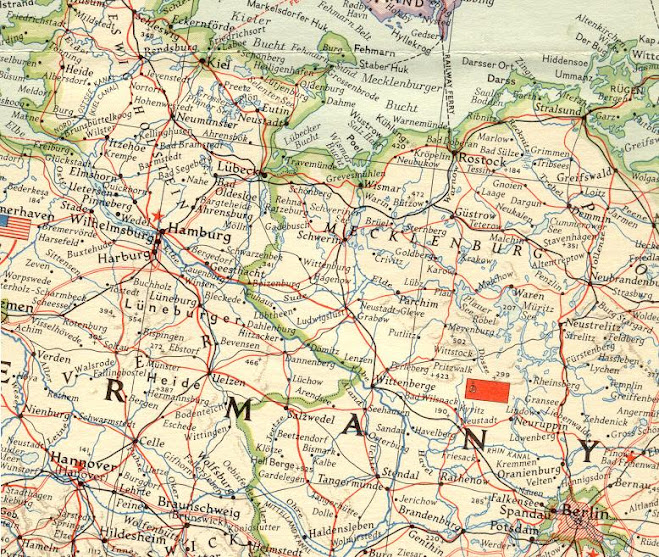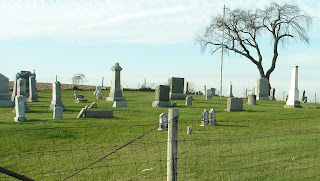Many family members were encouraged to emigrate to America for employment on the Railroads and as colonizers
St, Paul Archbishop John Ireland was recruiting in Europe and the Eastern United States for immigrants to settle ...Northern Pacific or Great Northern? The Ireland and J.J. Hill connect. Ireland was also serving as Agent and getting free land for Catholic Churches and Schools. Brochures and boosters were sent to villages suffering from economic times and those suffering from starvation, disease ie. cholera to encourage emigration and promising help in getting to the destination in a variety of ways.
A booth in European Expo promoting emigration to Minnesota. Saint Paul would become a Railway hub. The placement of railway yards was within walking distance of a high concentration of home of new immigrants with trade skills. Jobs included repair, cleaning crews "wipers". Also immigrants hired as chefs for over the road service.
The Burgenlander Emigration to America: "The first immigrant from Neusiedl am See was Johann Lichtscheidl (b.1863) who left in 1880 and ran a very success meat business in Minnesota. ...By 1892, 44 people had emigrated. In Neusiedl, there were five travel agencies, which indicates emigration on large scale, especially from the Seewinkel. There were 5 travel agencies ...The decrease of Viniculture was a further motive. Phylloxera destroyed entire vineyards during the 1890's... Most never replanted. *Phylloxera is a microscopic louse or aphid, that lives on and eats roots of grapes.
American Catholic lay groups and transatlantic social reform in the progressive era. by Dierdre M. Maloney about Archbishop John Ireland. Ireland.
Clontarf, a railroad town in Swift County, was established by Bishop John Ireland of St. Paul in 1877 as a Catholic colony on the prairie. Early arrivals named Clontarf for the site of the eleventh-century victory of the Irish king Brian Boru over Viking invaders.
The St. Paul and Pacific Railroad extended its track west from St. Paul to the Dakota Territory border at Breckinridge in 1871. About 140 miles west from St. Paul, a siding and a section house called Randall Station were built near present-day Clontarf. The sandy soil surrounding Randall Station was not attractive to farmers, leaving much of the land unsold and uncultivated. Railroads needed farms and communities along their tracks to make the lines sustainable.
In January 1876, Bishop Ireland announced the creation of the Catholic Colonization Bureau. The Bureau would act as agent for the St. Paul and Pacific Railroad to sell the 117,000 acres of unsold railroad land grants in Swift County. Much of the available railroad land was sold within two years. In 1878, James J. Hill and partners acquired the bankrupt St. Paul and Pacific Railroad, renamed it the St. Paul, Minneapolis and Manitoba, and began to extend the line to Puget Sound. In Clontarf, families arrived on Hill’s trains nearly every day to begin their new lives.
On the East Coast, Irish immigrant families, working in mines, mills, stone quarries, and factories, heard Bishop Ireland’s promise of affordable land, a Catholic church with a resident priest, and a community of Irish Americans. There, they hoped, they would be free from the immigrant bias that existed in their towns and cities. They came from Concord, New Hampshire; Salem, Massachusetts; and Southington, Connecticut. Irish families from Wisconsin, Minnesota, and other states joined them in the farmlands surrounding Clontarf.
The Catholic Church was fundamental to the Clontarf colony. Father Anatole Oster was assigned as the first priest in 1878 and he named the parish St. Malachy for an Irish saint. Father Oster was a native of France, which pleased the French-Canadian members of the parish who had farms north of Clontarf. In accordance with Ireland’s vision, Father Oster attended to both the spiritual and practical needs of the Clontarf residents.
Disturbed by reports that Catholic immigrants in eastern cities were suffering from social and economic handicaps, he organized and directed in Minnesota (1876-81) The most successful rural colonization program ever sponsored by the Catholic Church in the U.S. Working with the western railroads and with the state government, he brought more than 4,000 Catholic families from the slums of eastern urban areas and settled them on more than 400,00 acres of farmland in western Minnesota.
Irish Catholic Colonization Association
The Irish Catholic Colonization Association was founded by Archbishop John Ireland of St. Paul and Bishop John Spaulding of Peoria along with two laymen, William J. Onahan of Chicago and Dillon O’Brien of St. Louis. The men were disturbed by reports of the living conditions of Irish immigrants in Eastern cities, particularly the infant and child mortality rate, and felt that the Irish would be better off outside of larger cities. Bishop Spaulding, along with Ohahan and O’Brien, had been interested in Catholic colonization efforts for some time, and Archbishop Ireland and O’Brien had worked together on a similar project in Minnesota. From 1876 to 1881 Ireland successfully brought more than 4,000 Catholic families to over 400,000 acres of land in rural Minnesota.
The Association was founded on January 20, 1879, at a meeting of the St. Patrick’s Society in Chicago. The group solicited delegates from various colonization efforts across the country, and at its next meeting adopted a platform proposed by Archbishop Ireland. They organized a board of seven laymen and five Catholic bishops, including Ireland and Spalding. The goal of the Association was to raise money to buy plots of land in rural parts of the West and South and help resettle Irish Catholics from the urban areas. The Association believed that a rural lifestyle would better allow Irish Catholics to maintain their faith, as they would not be mingling with people of other religions or subject to the whims of corrupt politicians.
By the summer of 1879, the Association had purchased two large tracts of land: 8,000 acres in Minnesota and 25,000 acres in Nebraska. Much of the fundraising for the movement came from Catholics in the Northeast, with $17,000 coming in one fundraising push from Brooklyn churches, and another $7,000 from the Boston area. Spalding also published a book titled Religious Mission of the Irish People and Catholic Colonization to promote the work. In the early 1880s, around the time that Charlotte Grace O’Brien approached Archbishop Ireland, the Association had begun to advocate for Emigrant Aid Societies to be formed in the major port cities.
At the group’s meeting in Chicago in May of 1883, Bishop Ireland put O’Brien’s proposal to the Board of Directors. Since the previous year, the group had been working with immigration officials to establish a Bureau of Information at Castle Garden, the country’s main immigration port. The board voted to provide $1,000 a year toward a home for immigrant women for a period of five years, along with the Bureau, over which it would maintain control. Eugene Kelly, a prominent Catholic layman and Irish immigrant, donated $1,000 to the effort.
When Minnesota entered the union in 1858 as the 32nd State there were 60,000 residents mostly concentrated along the Upper Mississippi from the Twin Cities south to the Iowa border. Otherwise the state was mostly an unsettled wilderness in need of population. If settlers came, the wilderness would be carved up into counties and good times would roll with law and order, a county seat, courthouse, commissioners, a sheriff, a jail, and judges. Businesses, schools, churches, and the other amenities of American democratic civilization would soon follow. If a man of vision looked north and west from St. Paul between 1865 and 1890, the potential was clear.
James J. Hill, 1963 |
James J. Hill, the railway tycoon, was a man of exactly such vision, as was John Ireland, the Churchman. Hill began to monopolize rail traffic to all points west when he manipulated stocks to secure control of the bankrupt St. Paul and Pacific Railroad during the Panic of 1873. He obviously saw beyond Minnesota through the wide open spaces of the Great Plains all the way to the Pacific Coast. Hill's purview saw potential states in this unorganized wilderness, states created by people whose presence guaranteed prosperity for his railroads.
Enter John Ireland, a Churchman with promotional talents and a colonization scheme. Ireland promised to bring Catholics West with the lure of cheap land under terms of the federal Homestead Act of 1862. But Hill would have to provide low-cost transport from the old World and print the promotional brochures.1 If the plan succeeded, Ireland's power would grow because a stable population would need Irish priests, and eventually Irish suffragan bishops of the St. Paul Archdiocese.
By the 1890s both men had what they wanted. Hill's reward was that he became the wealthiest railroad magnate in America. For his part, Ireland saw the Church in Minnesota and the new states of North Dakota and South Dakota staffed almost exclusively by Irish priests and bishops from the Archdiocese of St. Paul. If Ireland should perchance receive the Red Hat of a Cardinal, Montana, Wyoming, Idaho, and Washington would also be under his wing
The St. Paul and Pacific Railroad, or St. P & P, was one of Minnesota’s first major railroads. It was created in 1862 from the remnants of another bankrupt line and strengthened by valuable land grants. It survived financial hardships to become a cornerstone of the Great Northern Railway system, a legendary transcontinental route and an integral part of Minnesota railroad history.
The Minnesota territorial legislature issued a charter to the Minnesota and Pacific Railroad Company (M&P) in 1857. Construction of the line began the same year. The new railroad was to connect Stillwater and St. Paul through outlying communities. To the west, it would be built out to Breckenridge with a branch line extending to St. Cloud.
The M&P was the first active railroad in Minnesota. The land grant it received from the territorial legislature—nearly 2,460,000 acres—ranked in the top ten of those awarded. However, finances were a problem from the beginning. The company lost money through speculation and was forced to sell its assets. It declared bankruptcy in 1860.
The new state legislature purchased the M&P’s assets for $1,000. The company was reorganized in 1862 as the St. Paul & Pacific Railroad Company (St. P&P). Workers completed ten miles of track between St. Paul and St. Anthony but little else. The branch line reached Sauk Rapids in 1867, financed largely by bonds sold to Dutch investors. Only 210 miles of track were laid by 1865. Almost no track is recorded to have been built between 1867 and 1871.
The Northern Pacific (NP) purchased the St. P & P in December 1870. When the NP was forced to declare bankruptcy after the Panic of 1873, one of its original chief stockholders bought it back. The NP’s Dutch investors, who had the line placed into receivership to little effect, held the majority of shares of St. P & P ownership.
The line was significant for a number of firsts, despite its hardships. The wood-burning 4-4-0 locomotive William Crooks was the first railroad locomotive in the state. It hauled passengers between St. Paul and St. Anthony for an inaugural run in 1862 after being delivered upstream from La Crosse on the Mississippi River.
The railroad attracted the attention of powerful investors for the potential that its land grants represented. Chief among them was steamboat magnate and Minnesota entrepreneur James J. Hill. Hill convinced other investors of the line’s potential and eventually formed a group to buy the St. P & P from the Dutch with a combined investment of $5.5 million dollars.
The Dutch transferred their bonds to Hill’s investment group on March 13, 1878, thus giving up control of the company. Bonds were issued for renewed construction on the railroad. With the new bonds, the owner could receive up to $10,000 per mile of track completed. In February 1879, Hill’s group of investors bought out the Litchfield investor group, which had owned so much of the line since 1862. The St. P & P had showed a profit in excess of $500,000 for 1878.
Two different courts permitted the company to exit bankruptcy status in 1879. The new investment group, having directed the St. P & P out of bankruptcy, formed a new entity to take over the company, and on May 23, 1879, they named it the St. Paul, Minneapolis and Manitoba Railway (St. P. M&M). The new company formally took over St. P & P assets in June 1879.
A decade later, James J. Hill ushered in the era of the Great Northern Railway. He changed the name of the Minneapolis and St. Cloud Railway to the Great Northern on September 18, 1889. Ownership of the St. P. M&M, the Montana Central Railway, and other systems was transferred to the Great Northern on February 1, 1890. Most of the modest, original right of way of the St. P & P lives on in the twenty-first century as trackage of the BNSF Railway system, which is itself a large system created by a massive railroad merger in 1995.






































